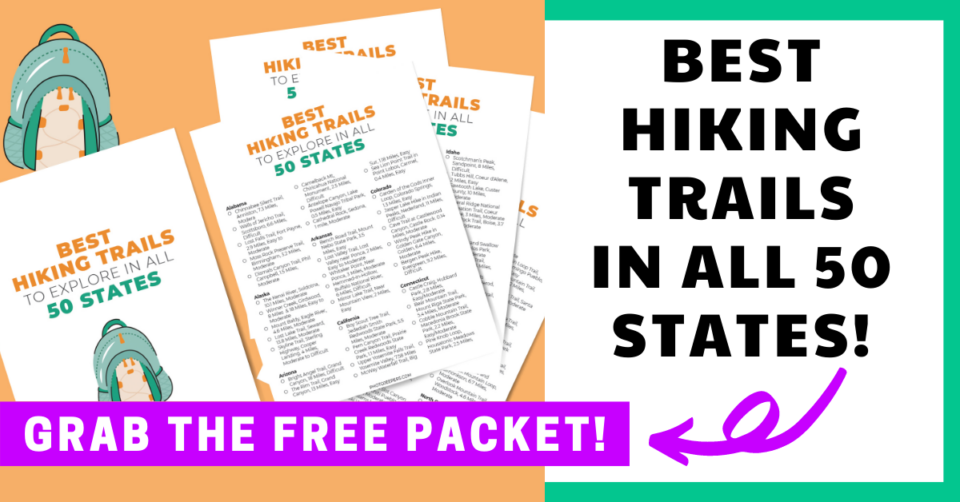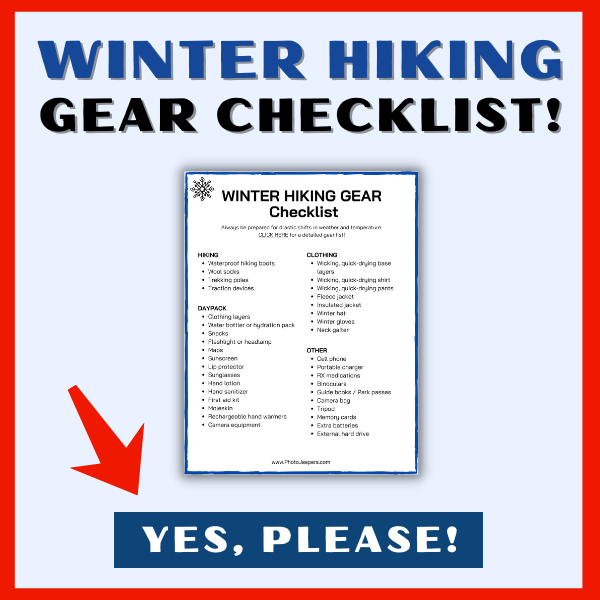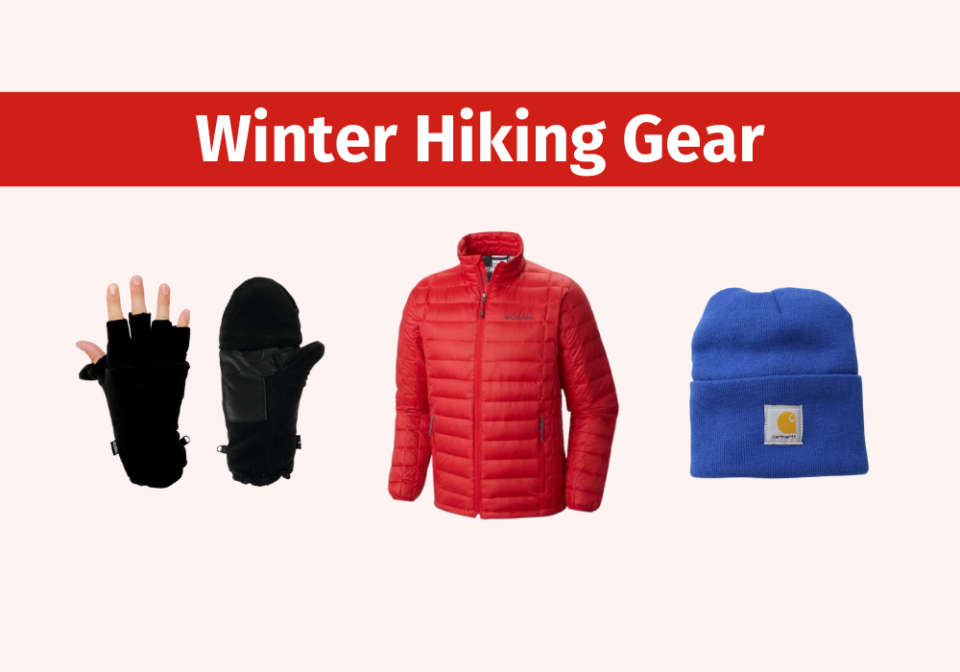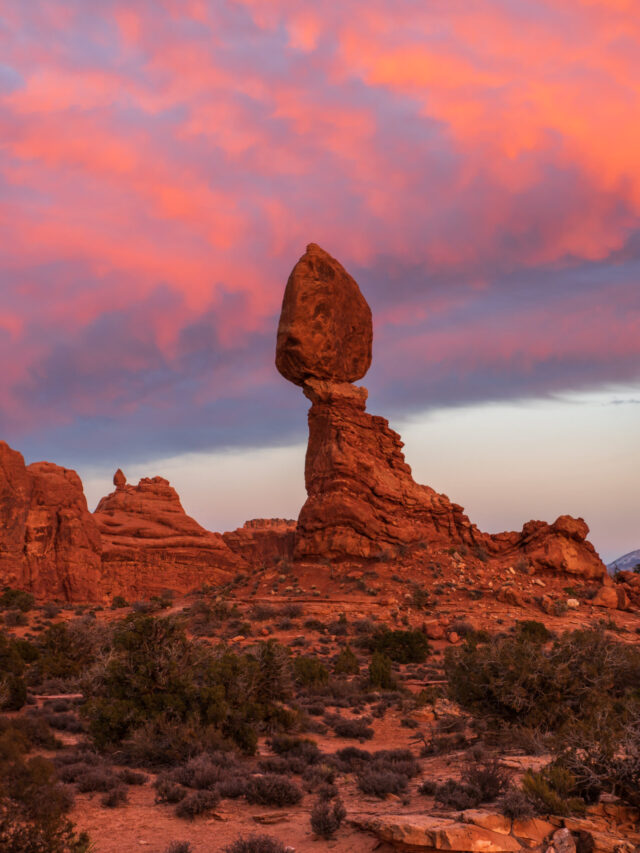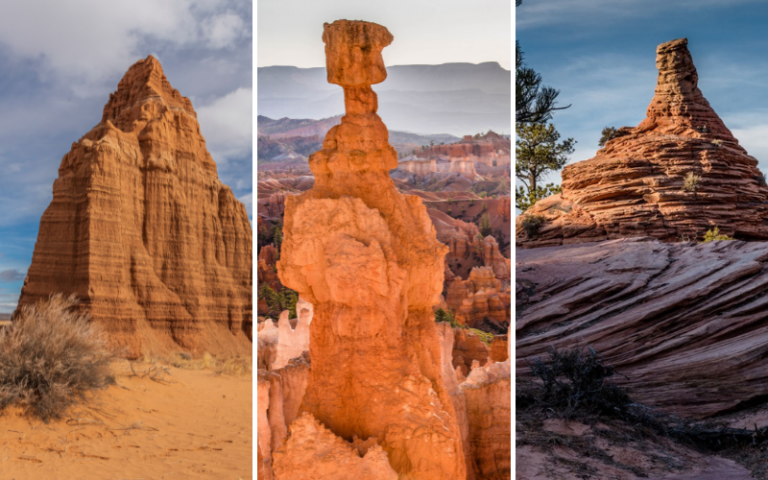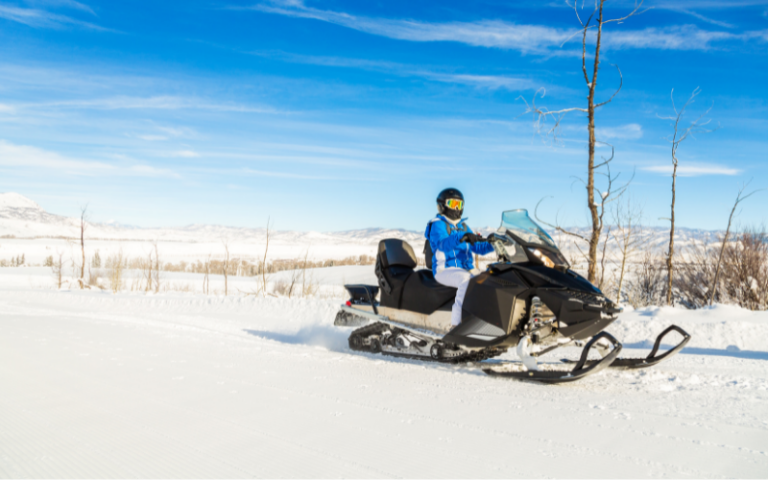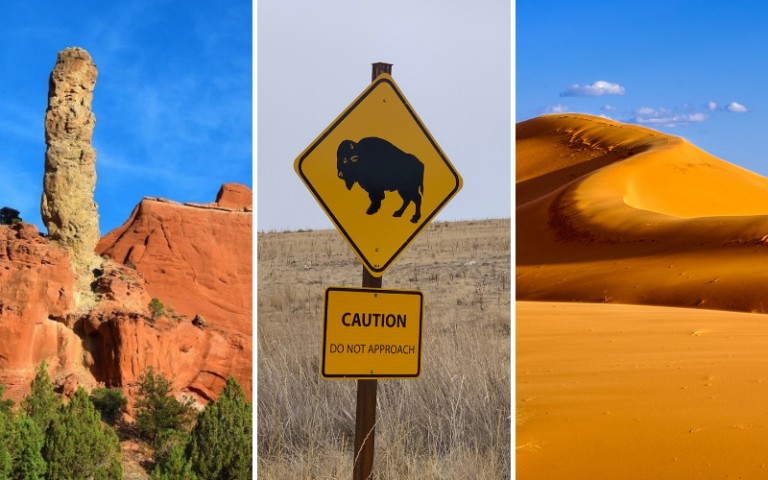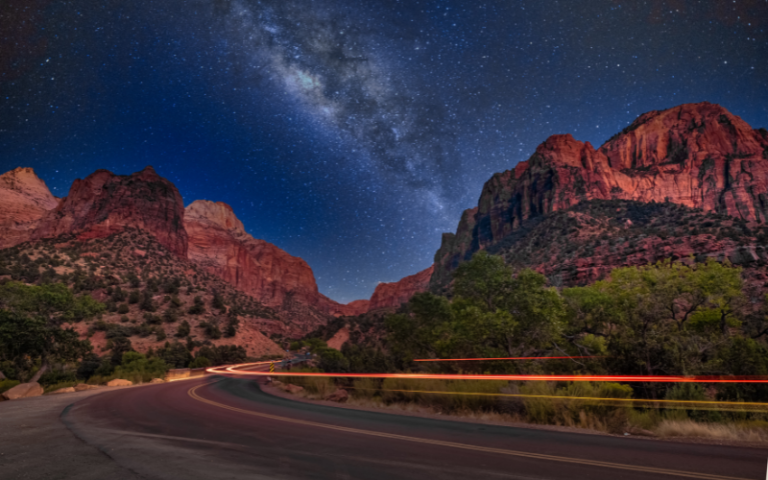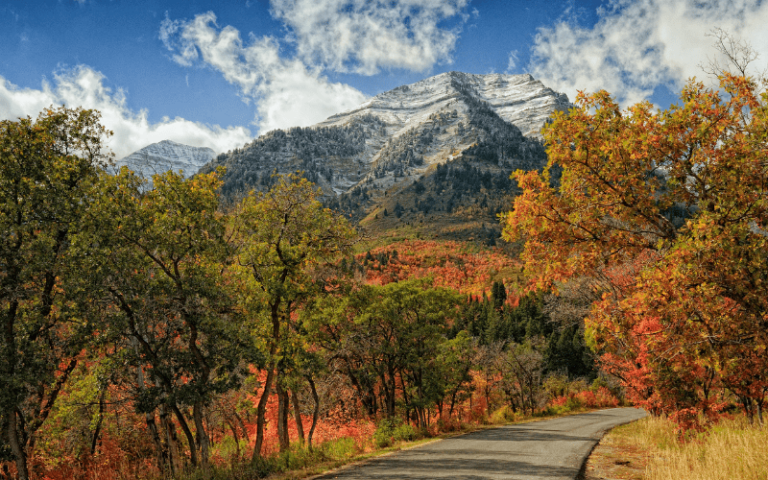Moab Winter Hikes + Travel Tips
There are amazing Moab winter hikes to explore during the offseason. The Moab area includes hiking trails in two National Parks, one State Park, and on BLM land.
Visiting Moab in the winter is our favorite time because it’s the off-season. There are fewer visitors and the rates to stay are lower than any other time of the year.
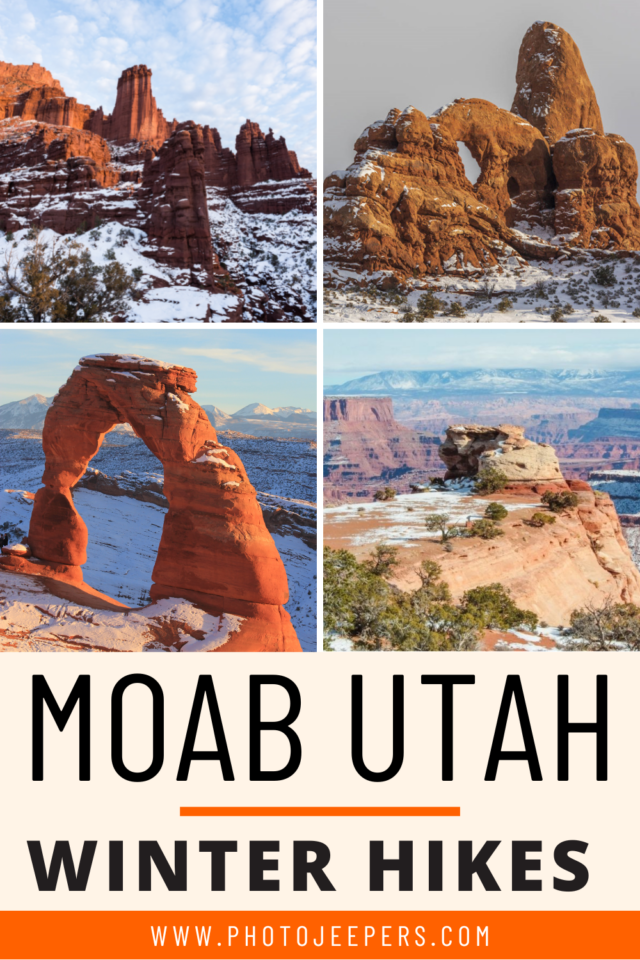
Use this Moab Utah Vacation Guide to plan your winter trip: hiking trails, weather, what to pack, where to stay and more!
One of the best Moab winter activities is hiking. It’s a terrific way to see and photograph this scenic area filled with sandstone arches, pinnacles, petroglyphs and even dinosaur prints!
This list of Moab winter hikes details the distance, time, elevation gain, and important information about what it’s like to hike each trail.
We live only a few hours away from Moab and have visited during every season and month of the year! The tips we share are based on our experiences visiting the area throughout the years, and specifically during the winter months!
Our number one tip is to dress for the weather! Use our winter hiking gear checklist to make sure you have the right clothing and gear for your hiking adventures during the winter months! Grab your free printable packing checklist by clicking the image below!
This site contains affiliate links which means WE may receive commissions for purchases made through these links. We only provide links to products we actually use and/or wholeheartedly recommend! As an Amazon Associate, we earn from qualifying purchases. Read the full Disclosure Policy.
A Photo Tour of Moab, Utah
Take a visual tour through the Moab, Utah area to see the stunning landscapes you’ll see when you visit!
Moab Winter Hiking Tips
Winter is the offseason for the Moab area that includes two of the five Utah National Parks. You’ll enjoy Moab and the parks without the summer crowds and heat!
Before heading out for any winter hiking, we recommend you check current trail conditions with the Visitor Center at the National or State Parks, or the Moab BLM office. Some trails may require traction devices if trails are icy.
Moab Winter Weather
During the winter, the Moab weather is cold and unpredictable, especially if a storm rolls through. Remember that Moab is about 4,000 feet above sea level so it does get cold in the winter, even if the sun is out.
- Moab in December: high 45 / low 22 – 3 days rain/snow
- Moab in January: high 44 / low 22 – 3 days rain/snow
- Moab in February: high 52 / low 26 – 3 days rain/snow
Dress in layers and pack warm winter clothing so you’ll actually want to get out of the car and enjoy the outdoor activities! Your hiking boots should be warm and waterproof. No one wants soggy feet!
After a snow storm, the Arches and Canyonlands roads might be closed for plowing for a few hours. Keep in mind that the roads, parking lots, and pullouts in the parks can still be icy, especially in shaded areas.
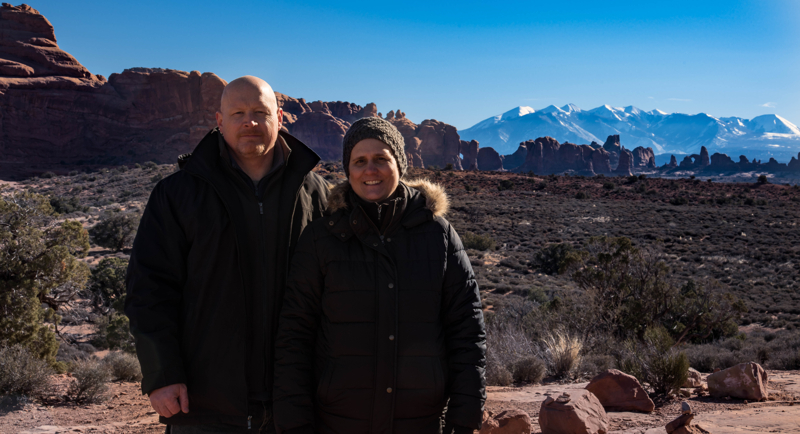
Winter Clothing for Hiking in Moab
Moab, Utah experiences cold weather in the winter. Be sure to wear and pack winter clothing essentials.
- Base Layers: Wicking base layers will give you the warmth you need to fight off the cold winter weather in Moab. Plus, you can take them off easily whenever you no longer need them.
- Fleece jackets: Fleece jackets serve as a light layer on warmer days in the park but can also add warmth to your layering.
- Insulated Jackets: Insulated jackets provide the perfect warmth whether you are going for a light hike or a more extended excursion.
- Wool socks: Do not wear cotton socks. It is best to wear wool socks for winter. Bring a spare just in case anything unexpected happens.
- Insulated hats: An insulated hat will protect you from losing too much of your body temperature through your head.
- Winter gloves: If it’s extremely cold, use an insulating glove inside a waterproof shell mitt to provide dexterity and warmth.
- Waterproof hiking boots: Hiking boots need to be waterproof. You may also need traction devices for some trails.
Winter Hiking Gear
Many of the Moab hiking areas like Canyonlands National Park have no services during the winter, so you must bring everything you need. Here’s the winter hiking gear we recommend:
- Water: At least two liters of water is enough for a day in Moab, but it does not hurt to bring more. Use a wide-mouth Nalgene water bottle since the narrow-mouth are prone to freeze shut more easily. A Neoprene bottle sleeve also works. Moab is a desert so dehydration remains a threat even in winter.
- First aid kit: No matter whether your hike is long or short, always pack a hiking first aid kit. Make sure your first aid kit has the essentials like plasters, bandages, anti-bacterial wipes, etc. Other items to pack for a winter day hike are a hiking lighter and a PLASTIC whistle.
- Headlamps: Carry a headlamp for winter hiking because there are fewer hours of daylight. Use lithium batteries for all electronic devices since they are resistant to cold temperatures.
- Snacks: Snacks are essential. Choose the ones that are easy to munch, so you can grab them to refuel your energy. Also, snacks that are high in protein and carbohydrates are strongly recommended.
Many of the trails around Moab are fully exposed to the sun so you’ll still need sunscreen, even in the winter.
Moab Winter Hikes
You’ll find a Moab hiking trail to suit any level of hiker. We recommend taking along your photography gear for hiking, especially if there’s snow. The contrast of white snow against the red rocks is so pretty!
Here’s a list of hikes you can explore around Moab in the winter:
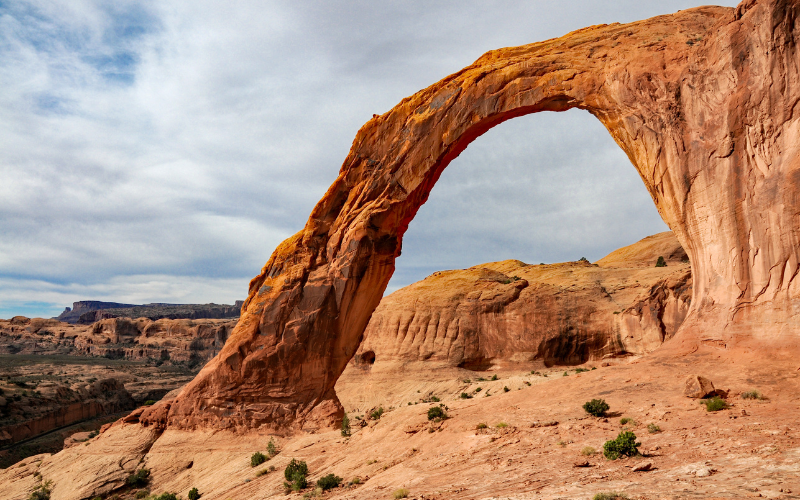
Corona Arch Winter Hike
- Hike length: 3 miles round trip
- Time required: 2 hours
- Hike difficulty: Moderate
- Trailhead Location: from Moab, take US-191 North for 4 miles. Turn left onto UT-279 South. Follow UT-279 for 10 miles. Parking and the trailhead are located on the north-side (right-side) of the highway.
The most popular Moab trail is the Corona Arch Hike. It offers stunning views along the way and the reward at the end is the 140-feet wide and 150-feet high Corona Arch. Combine the hike to include seeing Bowtie Arch while you’re here!
Corona Arch Trail is considered moderate due to a few areas where you’ll need to use cables to get up and down the slickrock slopes. This part of the hike could be slick during the winter.
Leashed pets are allowed on the trail.
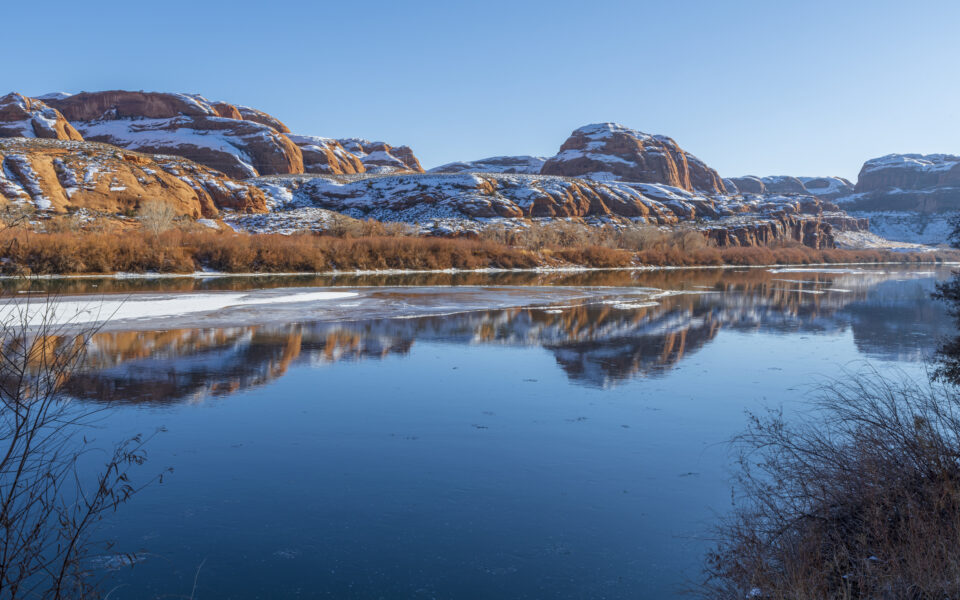
Be sure to give yourself time to see all the sites along the Potash-Lower Colorado River Scenic Byway after the hike! Winter is a great time to take pictures of this scenic area!
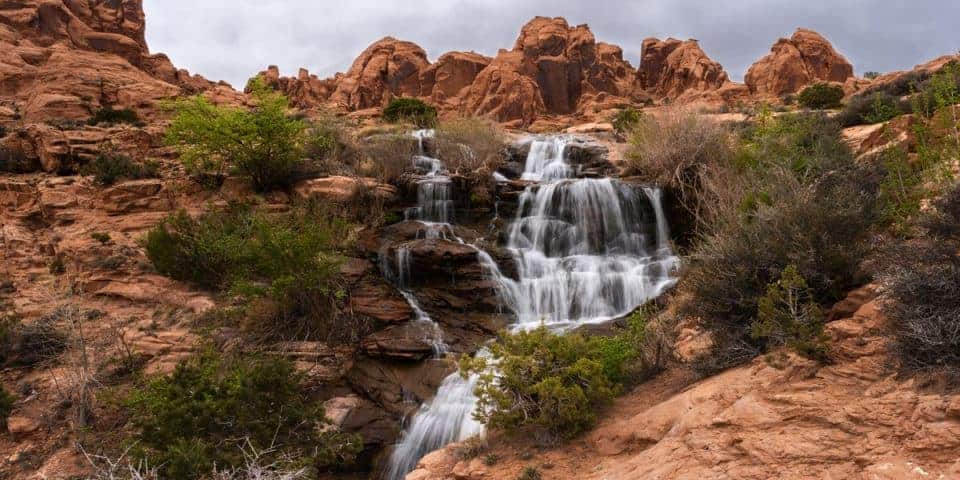
Faux Falls Winter Hike
- Hike length: 200 feet
- Time required: 15 minutes
- Hike difficulty: Easy
Directions to the trailhead:
- Go south out of Moab on highway 191 about 7.5 miles to mile marker 117.9.
- Turn left here, on the signed Kens Lake road. Reset your odometer.
- Follow this road 0.55 miles to a junction. Go right, toward the signed Mountain Loop Road. Reset your odometer again.
- 0.6 miles – Stay left.
- 1.4 miles – 4-way junction. Go left toward Kens Lake and reset your odometer.
- Continue straight at mile 0.6, instead of turning left into Ken’s Lake.
- 1.0 miles – Turn Left Into Campground
The trailhead has parking for several vehicles and contains an information kiosk. The last 1/2 mile of dirt road before the trailhead can become rough at times and some might want to park and walk it.
The Faux Falls Trail earned it’s name because the trail takes you to a waterfall created by the piping diverting water from Mill Creek to fill the reservoir, Ken’s Lake.
In the spring the waterfall is full and rushing due to the spring rains and snow runoff from the nearby mountains. When the temperature is below freezing, ice may form around the falls due to water spray. Use caution when walking on slippery surfaces.

Fisher Towers Winter Hike
- Hike length: 5.2 miles round trip
- Time required: 2 to 3 hours
- Hike difficulty: Easy
- Trailhead Location: Head north out of Moab a couple of miles to State Highway 128 (just before the Colorado River). Follow highway 128 about 21 miles to a signed turn off on the right. Follow the good dirt road 2.2 miles to it’s end at a small campground and parking lot.
The Fisher Towers Trail begins in the parking lot and descends a small set of steps to a ridge of Slickrock. This strenuous trail continues down into the ravine, where it narrows as it follows the cairns on the ridge.
As soon as the trail leaves the ravine, it climbs quickly and begins to wind directly beneath the Fisher Towers. The trail starts by traveling around the base of the largest tower in the park, The Titan. It then ascends upward to a ridge that provides an excellent view of Fisher Valley, the Colorado River, and the desert towers of Castle Valley.
In the winter you may find the trail is snow-covered or icy and may require traction devices. Be especially careful navigating up and down the slippery rocks!
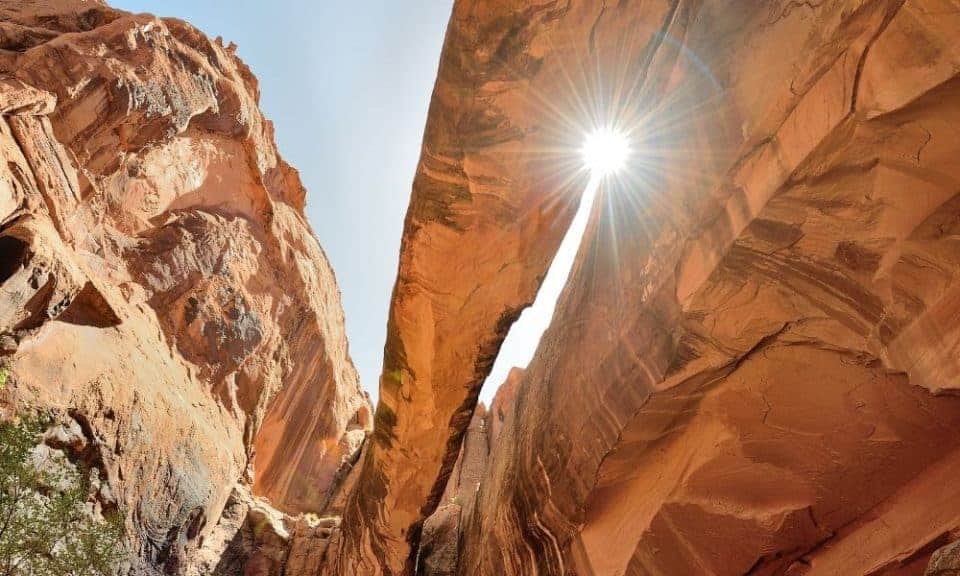
Grandstaff Canyon Winter Hike
- Hike length: 2 miles to Morning Glory
- Time required: 4 hours round trip
- Hike difficulty: Moderate
- Trailhead Location: The Grandstaff Canyon Trail is located three miles east of the junction with U.S. 191, Utah Scenic Byway 128.
The Grandstaff Canyon Trail is named after William Grandstaff, an African-American prospector in the 19th century. This trail is one of Moab’s most famous trails that offers a fun and exciting day adventure.
From the parking area next to Hwy 128, follow the trail up the left side of the stream. Snow and ice may be present during the winter months on this Moab hike.
Keep going upstream for about 1.5 miles. At the fork in the road, follow the trail to the right, cross the stream, and walk up the steep slope. Morning Glory Bridge is located at the end of the trail about 0.5 miles up the canyon from the stream.
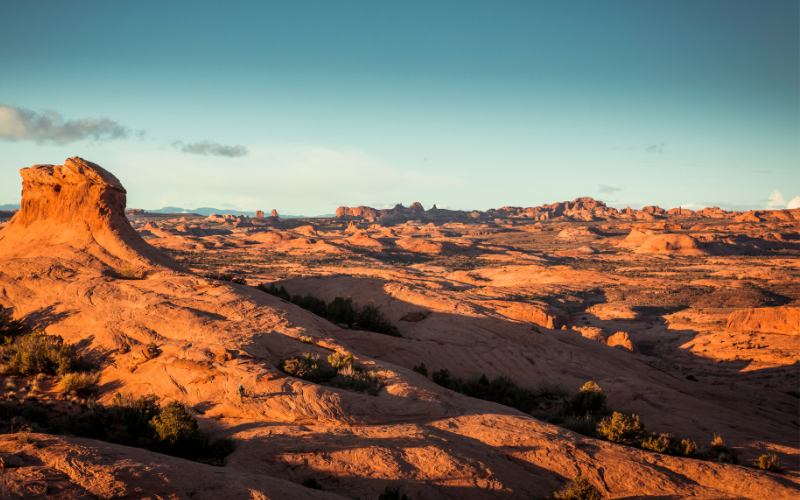
Juniper Trail Winter Hike
- Hike length: 1.9 miles round trip
- Time required: 45 minutes to 1 hour
- Hike difficulty: Easy
- Trailhead Location: located in the Sand Flats Recreation Area (fee to enter). Drive 6.3 miles from the entrance station and you’ll see a parking area.
The Juniper Trail is a well-maintained and easy-to-follow trail. It offers panoramic views of the Grandstaff, Mill Creek Canyons, Moab Rim, Porcupine Rim, La Sal Mountain range, and Colorado River channel.
Dogs are also able to use this trail but must be kept on leash.
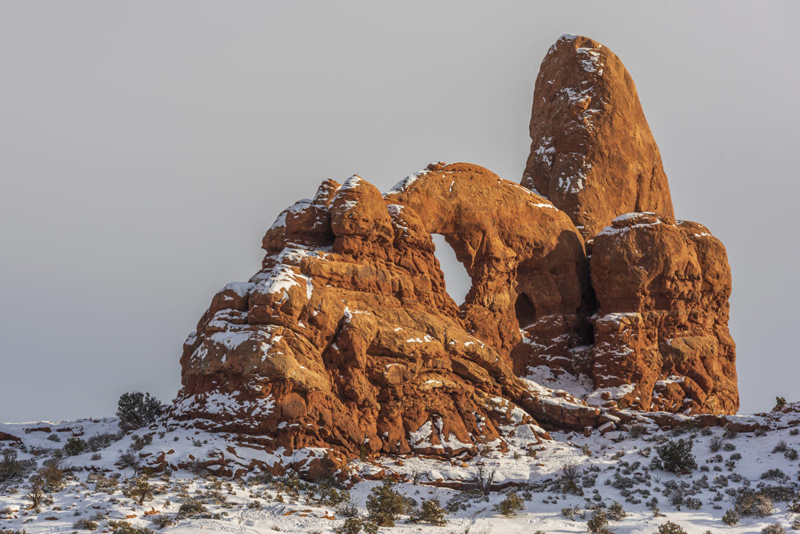
Winter Hikes at Arches National Park
One of the best Arches National Park winter activities is hiking. Check with the Visitor Center about trail conditions and whether traction devices are recommended.
Here’s a list of our favorite Arches National Park winter hikes:
- Park Avenue
- Balanced Rock
- The Windows and Turret Arch
- Double Arch
- Delicate Arch
- Sand Dune Arch and Broken Arch
- Skyline Arch
- Landscape Arch
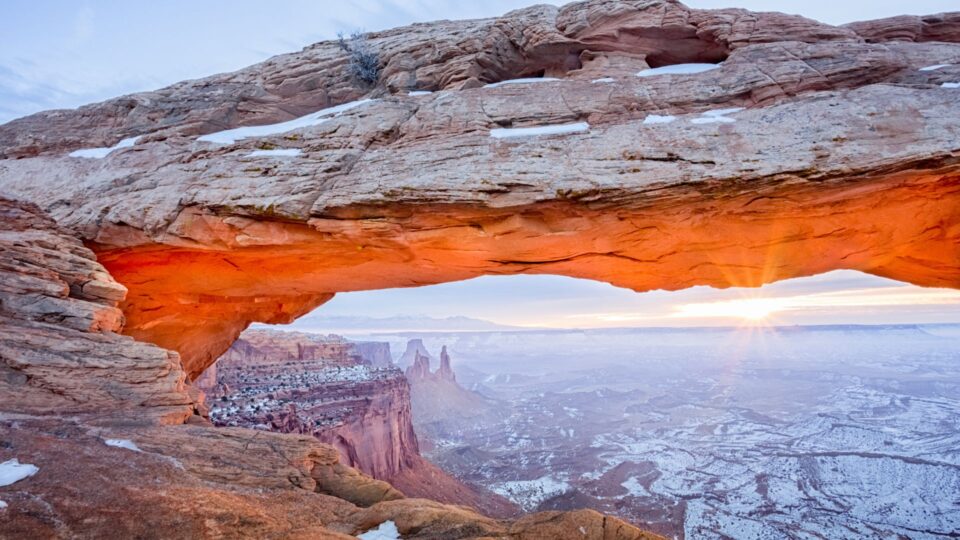
Winter Hikes at Canyonlands National Park
Before setting out on any Canyonlands National Park winter hike, check with the Visitor Center about trail conditions and whether traction devices are recommended.
One of the best Canyonlands winter activities is hiking. But due to the remote location of Canyonlands, always be prepared with water, food and proper clothing so you can be self-reliant.
Services are limited or closed in the winter. Remember there is no gas, food or lodging at Canyonlands National Park Island in the Sky or Needles Canyonlands.
Know what Canyonlands winter services are available as well as road and trail conditions before heading into the parks.
Here’s a list of winter Island in the Sky hikes:
- Mesa Arch
- Grand View Point
- White Rim Overlook
- Murphy Point
- Upheaval Dome
- Whale Rock
- Aztec Butte
Check out the winter Canyonlands Needles hikes:
- Roadside Ruin
- Pothole Point
- Cave Spring
- Chesler Park Loop
- Druid Arch
- Confluence Overlook
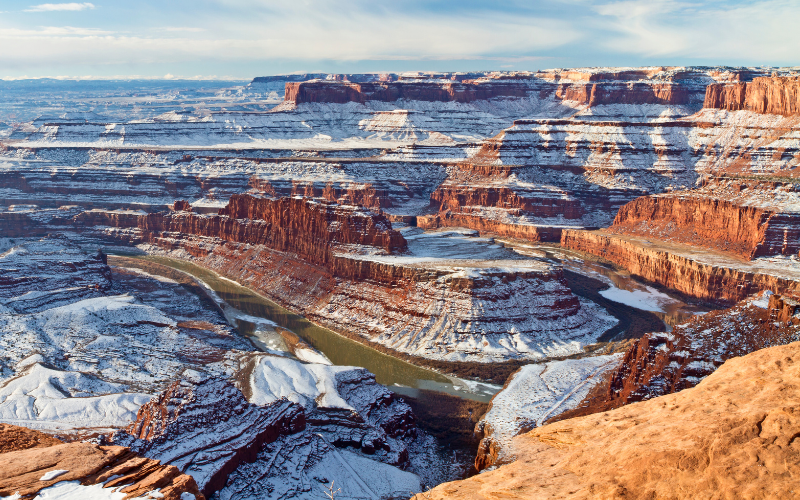
Dead Horse Point Winter Hikes
This Utah State Park is located near the entrance to Canyonlands National Park Island in the Sky.
The Dead Horse Point State Park hiking trails run along the top of the mesa and connect to each other. In the winter, the uneven slick rock trails can be icy or snow-covered. Check with the rangers about the conditions when you arrive.
Dogs are allowed on hiking trails, but must be kept on a leash at all times.
- Dead Horse Point Overlook Trail
- Visitor Center Nature Trail
- The Colorado River Overlook
- East Rim Trail System
- West Rim Trail System
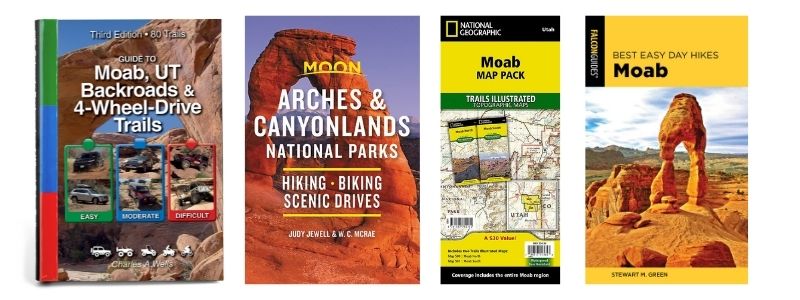
Moab Winter Lodging
Hiking Trails in All 50 States
Check out this list of the Best Hiking Trails in the US. We created a free printable that lists 5 amazing hikes per state! Click the graphic below to get your copy!
